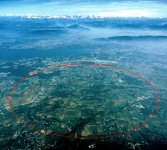- Joined
- Dec 29, 2006
- Messages
- 1,177
- Reaction score
- 61
- Points
- 48
- Location
- California, the golden state
- Your Mac's Specs
- G4 AGP 400 MHz 1.34gb RAM
Large Hadron Collider
LHC, is a facility at the European Center for Nuclear Research (CERN) on the French-Swiss border. It is designed to take particles at high energies and smash them together, to see what results are obtained. The energies of interest are above 1 TeV (tera-electron volt), or one million million electron volts.
The LHC was designed for versatility, allowing experiments in high-energy proton-proton collision, proton-electron collision, and collisions of heavy ions such as lead. The latter category of experiments could reach energies of thousands of TeV. In addition, the beam intensity is higher than other colliders of the time, allowing for more possible collision events. With each of these types of experiment, the LHC is designed to test the standard model of quantum mechanics. The heavy-ion collisions can provide particular insight into the nature of the strong nuclear force.
The LHC design includes a 27-km-long beam pipe through which the particles will travel to collide. Like most accelerators, it has a ring design, allowing for magnetized acceleration around the ring. The particles will remain in the system for fairly long times, raising concerns about synchrotron radiation potential chaotic effects. Synchrotron radiation the tendency of charged particles that are being accelerated to radiate energy is inevitable and must be compensated for in the beam itself. The magnetic guides are the most difficult part of damping the chaotic effects. Even small flaws in the magnetic system could be disproportionately deleterious to the experimental results.
The magnets used will be superconducting and will use the previously existing LEP (Large Electron Positron collider) tunnel for their accelerator chamber. The magnetic effects required are almost 100,000 times the strength of Earth's magnetic field. These superconducting magnets will be made of coils of copper-clad niobium-titanium cables, through which a strong current will pass. These magnets must be precisely coiled not just to prevent chaotic effects but also to prevent quenching breakdown, which costs the accelerator precious hours of beamtime. In order for these strong magnets to work, they must sit in 1.9K baths of superfluid helium. The cryogenics of this system have to be optimized for temperature and for fluid-tightness: spills of superfluid helium could be costly in both time and money.
The LHC is a highly ambitious project, lying before the cutting edge of particle physics at the time of the writing of this article. It is expected, among other things, to verify the existence of quark-gluon plasmas and to test other fundamental parts of current particle theory. The scheduled starting date of the LHC is 2005.
http://www.interactions.org/LHC/what/index.html
http://www.interactions.org/imagebank/search_or.php?offset=0&limit=5&keywords=LHC

LHC, is a facility at the European Center for Nuclear Research (CERN) on the French-Swiss border. It is designed to take particles at high energies and smash them together, to see what results are obtained. The energies of interest are above 1 TeV (tera-electron volt), or one million million electron volts.
The LHC was designed for versatility, allowing experiments in high-energy proton-proton collision, proton-electron collision, and collisions of heavy ions such as lead. The latter category of experiments could reach energies of thousands of TeV. In addition, the beam intensity is higher than other colliders of the time, allowing for more possible collision events. With each of these types of experiment, the LHC is designed to test the standard model of quantum mechanics. The heavy-ion collisions can provide particular insight into the nature of the strong nuclear force.
The LHC design includes a 27-km-long beam pipe through which the particles will travel to collide. Like most accelerators, it has a ring design, allowing for magnetized acceleration around the ring. The particles will remain in the system for fairly long times, raising concerns about synchrotron radiation potential chaotic effects. Synchrotron radiation the tendency of charged particles that are being accelerated to radiate energy is inevitable and must be compensated for in the beam itself. The magnetic guides are the most difficult part of damping the chaotic effects. Even small flaws in the magnetic system could be disproportionately deleterious to the experimental results.
The magnets used will be superconducting and will use the previously existing LEP (Large Electron Positron collider) tunnel for their accelerator chamber. The magnetic effects required are almost 100,000 times the strength of Earth's magnetic field. These superconducting magnets will be made of coils of copper-clad niobium-titanium cables, through which a strong current will pass. These magnets must be precisely coiled not just to prevent chaotic effects but also to prevent quenching breakdown, which costs the accelerator precious hours of beamtime. In order for these strong magnets to work, they must sit in 1.9K baths of superfluid helium. The cryogenics of this system have to be optimized for temperature and for fluid-tightness: spills of superfluid helium could be costly in both time and money.
The LHC is a highly ambitious project, lying before the cutting edge of particle physics at the time of the writing of this article. It is expected, among other things, to verify the existence of quark-gluon plasmas and to test other fundamental parts of current particle theory. The scheduled starting date of the LHC is 2005.
http://www.interactions.org/LHC/what/index.html
http://www.interactions.org/imagebank/search_or.php?offset=0&limit=5&keywords=LHC




